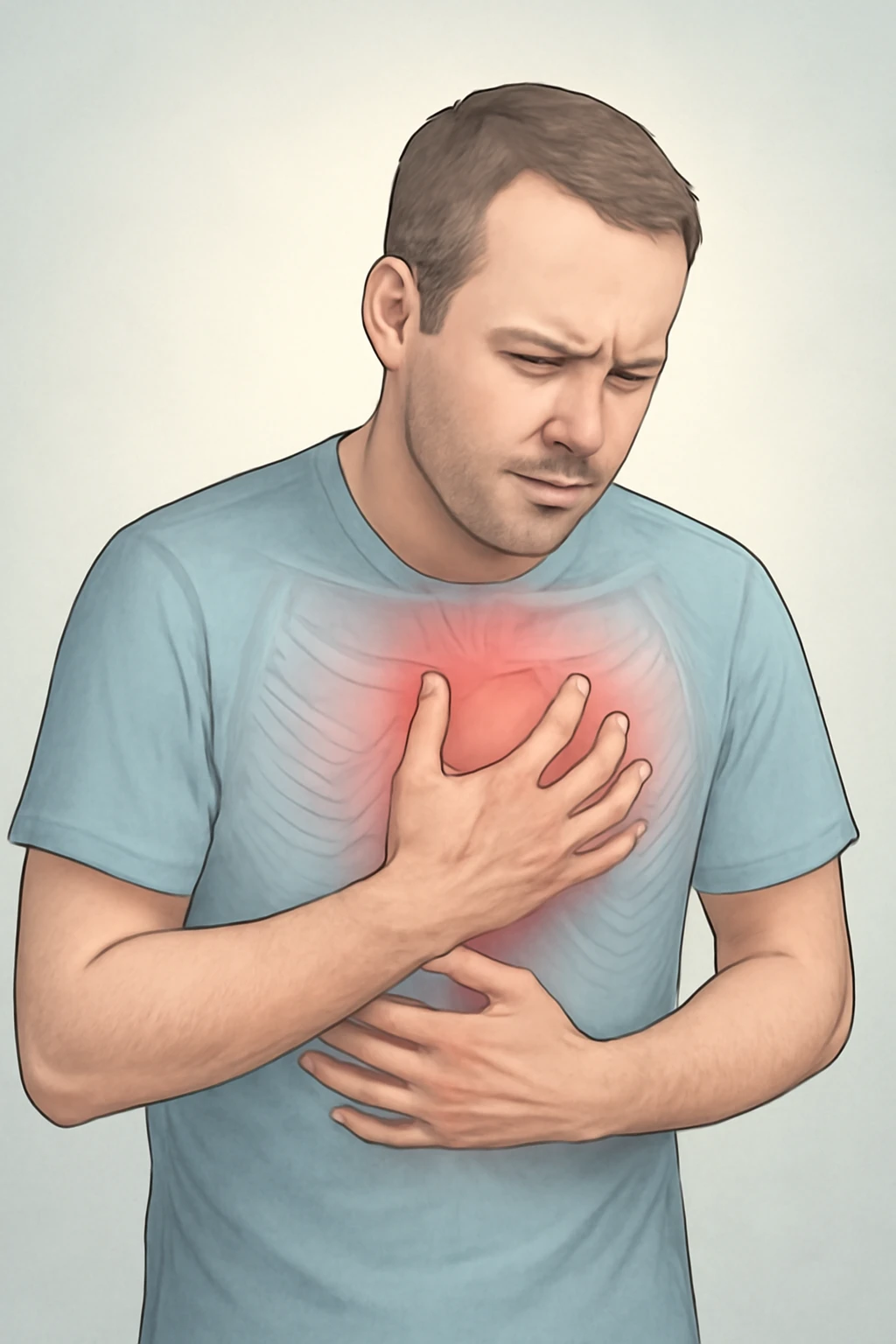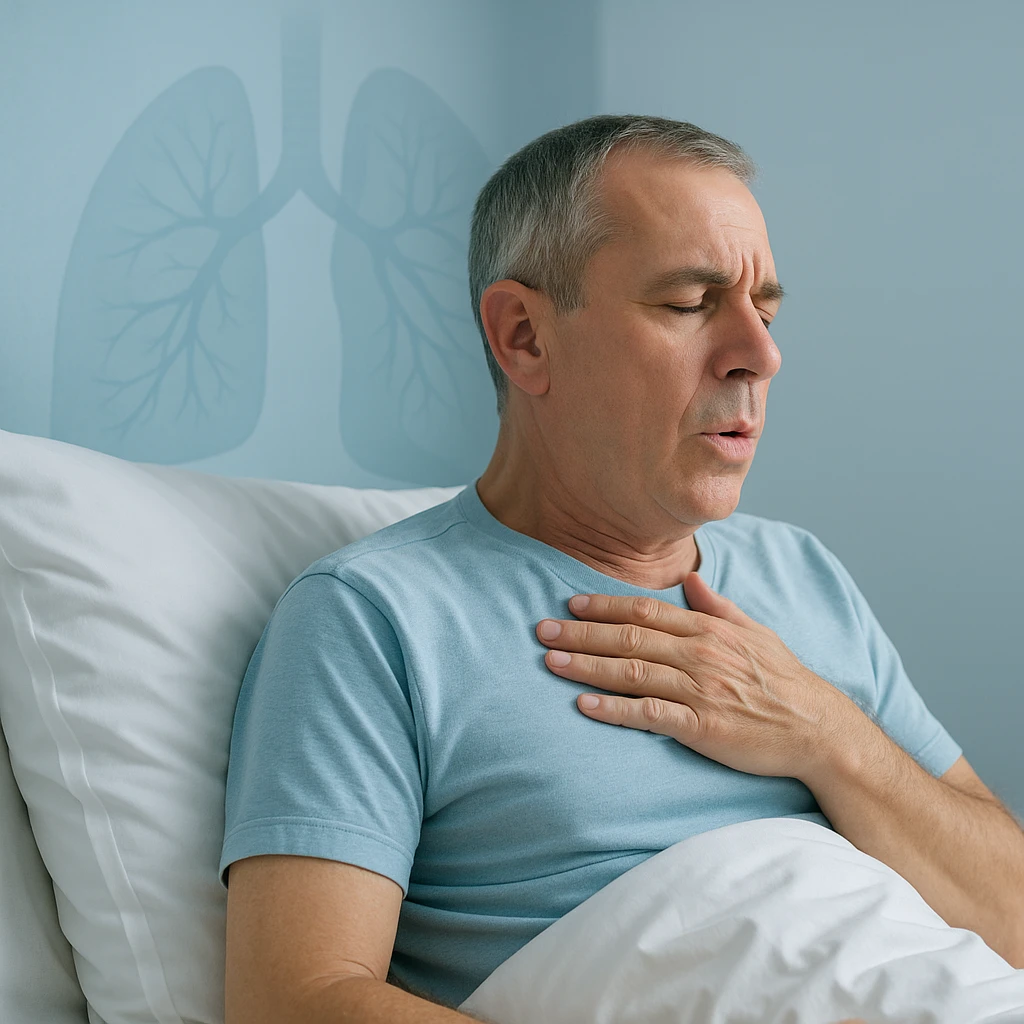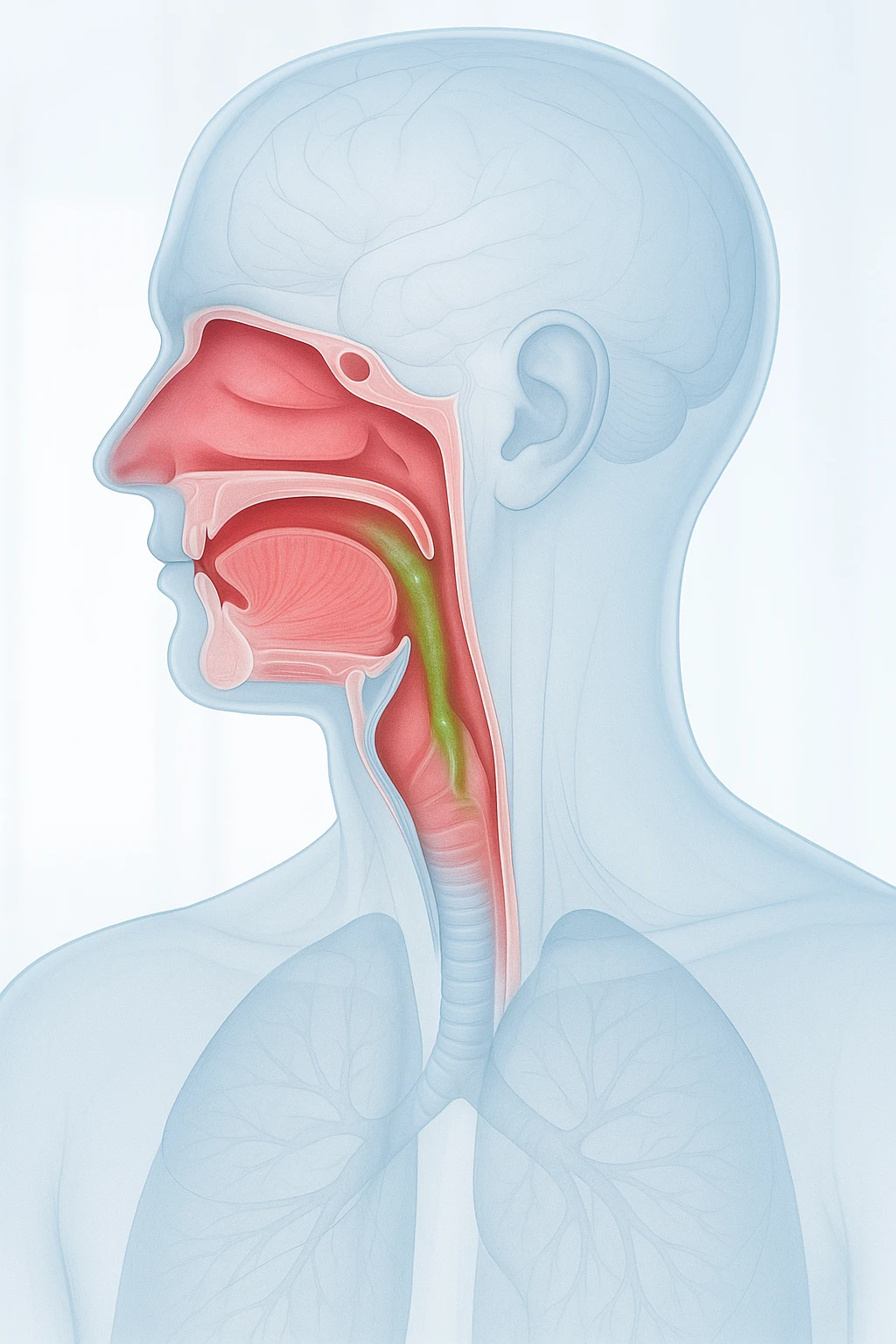Tight Chest: Key Causes and When to Seek Medical Help
What is Chest Tightness?
Tight chest is a common sensation experienced by many people. It often feels like pressure, heaviness, or a band-like tightness around the chest. This feeling can vary from mild discomfort to more severe sensations that cause difficulty breathing or a feeling of suffocation. Chest tightness can have different causes, some temporary and harmless, while others may require medical attention.
In many cases, tight chest may occur during stressful situations, as anxiety or emotional stress can cause muscles in the chest to contract, leading to a tight or heavy feeling. It may also be associated with physical conditions such as heart disease, lung issues, or digestive problems. Understanding the difference between benign and potentially serious causes is crucial for determining when medical help is needed.
Common Causes of Chest Tightness
Tight chest can occur for various reasons, ranging from benign to serious conditions. While it can sometimes be harmless, chest tightness may also signal an underlying health issue that requires attention. Common causes include anxiety, stress, cardiovascular conditions, lung problems, and digestive issues.
Anxiety and Stress
Anxiety and stress are common causes of tight chest. When a person experiences anxiety, their body releases hormones like adrenaline, which can cause the muscles in the chest to tighten. This can lead to a feeling of pressure or heaviness in the chest, often accompanied by difficulty breathing or a sensation of suffocation. Anxiety-induced tight chest is usually temporary and can be managed with stress reduction techniques or therapy. However, it may recur during times of heightened stress.
Cardiovascular Conditions
Heart disease and other cardiovascular conditions can also cause tight chest. Angina, a condition caused by reduced blood flow to the heart, presents as a feeling of pressure or tightness in the chest. Chest tightness associated with heart problems may signal a heart attack or other serious heart conditions and requires immediate medical attention. If chest tightness is accompanied by pain, shortness of breath, or dizziness, emergency care should be sought.
Respiratory and Digestive Causes
Lung conditions such as asthma, pneumonia, or chronic obstructive pulmonary disease (COPD) can lead to tight chest. These conditions often involve inflammation or constriction of the airways, making breathing difficult. Digestive issues like acid reflux or gastroesophageal reflux disease (GERD) can also cause chest tightness, particularly after eating. In these cases, the sensation is often accompanied by heartburn or a sour taste in the mouth.
Symptoms of Chest Tightness
Tight chest can manifest in different ways, with symptoms ranging from mild discomfort to more intense sensations that may require medical attention. Understanding how chest tightness manifests is important for distinguishing between benign issues and serious conditions. The following symptoms are commonly associated with tight chest:
-
Pressure, Heaviness, and Shortness of Breath
The sensation of pressure or heaviness in the chest is a common symptom. This feeling can make breathing difficult and may be accompanied by shortness of breath, where it becomes harder to take a full breath. Mild chest tightness may result from stress or anxiety, but when it is persistent or more intense, it could signal heart disease or a lung disorder.
-
Pain and Discomfort Variability
Chest tightness may vary in intensity and may or may not be associated with pain. This pain can be sharp or dull, and it may radiate to other parts of the body, such as the arms, back, neck, or jaw. If chest tightness is accompanied by sharp pain or shortness of breath, it could indicate a serious cardiovascular issue, requiring immediate medical attention.
Diagnosis and When to Seek Medical Help
Tight chest can result from various causes, and while some causes are benign, others may be more serious. Recognizing when to seek medical help and understanding the diagnostic process is crucial for timely treatment of any underlying conditions.
When to Seek Medical Attention
- If chest tightness is accompanied by sharp or persistent pain.
- If you experience shortness of breath, dizziness, or nausea.
- If the chest tightness worsens over time or occurs suddenly.
- If pain radiates to the arm, back, neck, or jaw.
- If you have a history of heart disease or respiratory conditions, even with mild symptoms.
These signs could indicate a serious cardiovascular issue, such as a heart attack or angina, and require immediate medical evaluation.
Diagnostic Process
Diagnosing the cause of chest tightness involves a thorough medical history and physical examination. The healthcare provider will ask about the symptoms, their duration, and any possible triggers. Risk factors for heart disease or lung problems will also be assessed. Diagnostic tests, such as an electrocardiogram (EKG) to monitor heart activity, chest X-rays to examine the lungs and heart, and blood tests to check for markers of heart damage or infection, may be recommended. These tests help distinguish between cardiac and non-cardiac causes of chest tightness, which is critical for appropriate management.
Treatment for Chest Tightness
Treatment for chest tightness depends on its underlying cause. While some cases may require minor interventions like stress management, others may require more complex treatments for heart or lung conditions. The treatment approach is tailored to the specific cause of tight chest, whether related to anxiety, cardiovascular problems, or respiratory conditions.
Managing Anxiety-Related Chest Tightness
For anxiety-induced chest tightness, the focus is on reducing stress and managing anxiety. Techniques such as deep breathing exercises, meditation, and yoga can help alleviate symptoms. Cognitive-behavioral therapy (CBT) is another effective treatment for anxiety-related chest tightness. Medications like anti-anxiety drugs or antidepressants may also be prescribed to manage anxiety.
Medical Interventions for Cardiovascular and Respiratory Causes
If tight chest is caused by cardiovascular or respiratory issues, treatment may include medications like nitrates or beta-blockers to improve blood flow and reduce the heart’s workload. Severe cases may require procedures like angioplasty or surgery. Respiratory conditions like asthma, COPD, or pneumonia may be treated with bronchodilators, corticosteroids, or antibiotics. Lifestyle changes such as quitting smoking, eating a balanced diet, and increasing physical activity are important for managing these conditions and reducing future episodes of tight chest.
Prevention and Long-Term Management
Preventing and managing chest tightness over the long term requires a combination of lifestyle changes and ongoing care. Many causes, including stress, anxiety, and respiratory conditions, can be mitigated through healthier habits, helping to reduce the frequency and severity of tight chest episodes.
Lifestyle Changes for Prevention
- Regular Exercise: Regular physical activity improves cardiovascular health, boosts lung function, and reduces stress, all of which contribute to reducing tight chest.
- Healthy Diet: A balanced diet with fruits, vegetables, and whole grains helps maintain a healthy weight and reduces the risk of heart disease, which can lead to tight chest.
- Smoking Cessation: Quitting smoking is essential, as smoking is a major risk factor for respiratory and cardiovascular problems that contribute to chest tightness.
Managing Chronic Chest Tightness
- Stress Management: Relaxation exercises, mindfulness, and therapy can help manage anxiety-related chest tightness.
- Respiratory Care: Regular medical care, adherence to medications, and lifestyle modifications are key to managing chronic respiratory conditions like asthma or COPD.
- Healthy Lifestyle Choices: Continuing healthy habits, including exercise, diet, and stress management, helps prevent chest tightness exacerbations.
Treatment for Chest Tightness
The treatment for tight chest depends largely on its underlying cause. While some cases may require only minor interventions such as stress management, others may involve more complex medical treatments for heart or lung conditions. The approach to treatment is tailored to address the specific issue causing the chest tightness, whether it is related to anxiety, cardiovascular problems, or respiratory conditions.
Managing Anxiety-Related Chest Tightness
Anxiety-related tight chest is a common condition that can cause significant discomfort. Treatment typically focuses on reducing stress and managing anxiety. Below are some of the treatment options:
- Relaxation techniques: Deep breathing exercises, meditation, and yoga can help alleviate symptoms by promoting relaxation and reducing muscle tension in the chest.
- Cognitive-behavioral therapy (CBT): An effective treatment to manage negative thought patterns that contribute to anxiety.
- Medications: In some cases, anti-anxiety drugs or antidepressants may be prescribed to help manage the underlying anxiety.
Medical Interventions for Cardiovascular and Respiratory Causes
If chest tightness is caused by cardiovascular or respiratory issues, medical treatment will vary depending on the specific condition. Common treatments include:
- Heart-related tight chest: Medications such as nitrates or beta-blockers may be used to improve blood flow and reduce the workload on the heart. In more severe cases, procedures such as angioplasty or surgery may be required.
- Respiratory conditions: Conditions like asthma, COPD, or pneumonia may be treated with bronchodilators, corticosteroids, or antibiotics, depending on the cause.
- Lifestyle changes: Quitting smoking, improving diet, and increasing physical activity can significantly help manage these conditions and reduce the risk of future chest tightness.
Prevention and Long-Term Management
Preventing and managing tight chest over the long term requires a combination of lifestyle changes and ongoing care. Many of the common causes of chest tightness, including stress, anxiety, and respiratory conditions, can be mitigated through healthier habits. By focusing on proactive management, individuals can reduce the frequency and severity of tight chest episodes and improve overall well-being.
Lifestyle Changes for Prevention
Adopting a healthier lifestyle is one of the most effective ways to reduce the risk of chest tightness. Here are some key lifestyle changes:
- Regular Exercise: Regular physical activity can improve cardiovascular health, boost lung function, and alleviate stress, all of which contribute to reducing chest tightness.
- Healthy Diet: A balanced diet rich in fruits, vegetables, and whole grains helps maintain a healthy weight and prevent conditions like heart disease, which can lead to chest tightness.
- Smoking Cessation: Smoking is a major risk factor for respiratory and cardiovascular issues that cause tight chest. Quitting smoking significantly reduces these risks.
By making these lifestyle changes, individuals can significantly reduce their risk of developing chest tightness.
Managing Chronic Chest Tightness
For individuals experiencing chronic chest tightness, especially those with anxiety or long-term respiratory conditions, ongoing management is necessary. Effective strategies for managing chronic chest tightness include:
- Stress Reduction Techniques: Relaxation exercises, mindfulness, and therapy can help manage anxiety-related tight chest. Medications may also be prescribed when needed.
- Medical Care for Respiratory Conditions: Regular care, adherence to prescribed medications, and lifestyle changes such as avoiding triggers can help manage conditions like asthma or COPD that contribute to tight chest.
- Healthy Lifestyle Choices: Continued focus on healthy living, including exercise, diet, and stress management, helps prevent exacerbations of chest tightness.
Managing chronic conditions and making healthy choices can improve quality of life and prevent exacerbations of chest tightness in the long run.
- Tight chest can result from anxiety, stress, cardiovascular issues, lung problems, or digestive issues.
- Heart disease and respiratory conditions are serious causes of chest tightness.
- Common symptoms include pressure, heaviness, and shortness of breath.
- Tight chest may occur with or without pain, which can be sharp or dull.
- Diagnosis involves medical history, physical exams, and tests like EKGs, chest X-rays, and lab work.
- Distinguishing between cardiac and non-cardiac causes is crucial for proper treatment.
- Treatment depends on the cause, including medications, therapy, lifestyle changes, or surgery.
- Managing anxiety-related tight chest may involve stress reduction, therapy, and medications.
- What is tight chest?
- Tight chest is a sensation of pressure, heaviness, or a band-like tightness around the chest, often causing discomfort or difficulty breathing.
- How can anxiety cause tight chest?
- Anxiety triggers the release of stress hormones like adrenaline, causing chest muscles to tighten, leading to a sensation of pressure or heaviness in the chest.
- What are the main causes of chest tightness?
- Tight chest can result from anxiety, stress, heart disease, lung issues, or digestive conditions like acid reflux.
- When should I seek medical help for chest tightness?
- If chest tightness is accompanied by sharp pain, shortness of breath, dizziness, or nausea, it is important to seek medical attention immediately.
- Can chest tightness indicate a heart attack?
- Yes, chest tightness can be a sign of heart problems like angina or a heart attack, especially when combined with pain, shortness of breath, or dizziness.
- How is chest tightness diagnosed?
- Diagnosis typically involves medical history, physical exams, and tests such as EKGs, chest X-rays, and blood work to determine the cause.
- What treatments are available for chest tightness?
- Treatment depends on the cause and may include medications, therapy, lifestyle changes, or surgical procedures for more serious conditions.
- Can chest tightness be prevented?
- Yes, lifestyle changes like regular exercise, a healthy diet, and smoking cessation can help prevent chest tightness, particularly when related to cardiovascular or respiratory conditions.
- What are common symptoms associated with chest tightness?
- Common symptoms include pressure, heaviness, shortness of breath, and pain, which can vary in intensity and may radiate to other areas of the body.
- What should I do if chest tightness keeps recurring?
- If chest tightness occurs frequently, especially with anxiety or underlying health conditions, it’s important to consult a healthcare provider for ongoing management and treatment.













